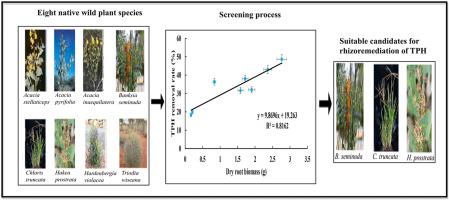Chemosphere ( IF 8.8 ) Pub Date : 2021-02-26 , DOI: 10.1016/j.chemosphere.2021.130135 Son A. Hoang , Dane Lamb , Balaji Seshadri , Binoy Sarkar , Ying Cheng , Liang Wang , Nanthi S. Bolan

|
Rhizoremediation potential of different wild plant species for total (aliphatic) petroleum hydrocarbon (TPH)-contaminated soils was investigated. Three-week-old seedlings of Acacia inaequilatera, Acacia pyrifolia, Acacia stellaticeps, Banksia seminuda, Chloris truncata, Hakea prostrata, Hardenbergia violacea, and Triodia wiseana were transplanted in a soil contaminated with diesel and engine oil as TPH at pollution levels of 4,370 (TPH1) and 7,500 (TPH2) mg kg-1, and an uncontaminated control (TPH0). After 150 days, the presence of TPH negatively affected the plant growth, but the growth inhibition effect varied between the plant species. Plant growth and associated root biomass influenced the activity of rhizo-microbiome. The presence of B. seminuda, C. truncata, and H. prostrata significantly increased the TPH removal rate (up to 30% compared to the unplanted treatment) due to the stimulation of rhizosphere microorganisms. No significant difference was observed between TPH1 and TPH2 regarding the plant tolerance and rhizoremediation potentials of the three plant species. The presence of TPH stimulated cluster root formation in B. seminuda and H. prostrata which was associated with enhanced TPH remediation of these two members of Proteaceae family. These results indicated that B. seminuda, C. truncata, and H. prostrata wild plant species could be suitable candidates for the rhizoremediation of TPH-contaminated soil.
中文翻译:

野生Proteaceae植物物种通过成簇根的形成改善石油烃的根际修复和土壤微生物活性
研究了不同野生植物物种对总(脂族)石油烃(TPH)污染土壤的根际修复潜力。三周龄苗相思inaequilatera,相思梨,相思stellaticeps,木香seminuda,虎尾草截形,Hakea草,Hardenbergia violacea,和Triodia wiseana在4,370污染程度污染的柴油和机油作为TPH土壤移植( TPH1)和7,500(TPH2)mg kg -1,以及未污染的对照(TPH0)。150天后,TPH的存在对植物的生长产生了负面影响,但生长抑制作用因植物种类而异。植物的生长和相关的根生物量影响了根际微生物组的活性。的存在B. seminuda,C.截形,和H.草显著增加了TPH移除速率(高达30%相比,unplanted处理)由于根际微生物的刺激。在这三种植物的植物耐受性和根际修复潜力方面,TPH1和TPH2之间没有观察到显着差异。TPH的存在刺激半裸芽孢杆菌和prostrata中簇簇根的形成这与加强Proteaceae家族的这两个成员的TPH修复有关。这些结果表明B. seminuda,C.截形,和H.莲草野生植物物种可能是TPH污染土壤的根际修复合适的人选。


























 京公网安备 11010802027423号
京公网安备 11010802027423号